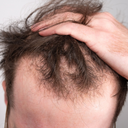Having an uneven hairline is not a pleasant experience.
In fact, according to this research, asymmetrical features are generally considered less attractive on a biological and evolutionary perspective.
Worry not, in this article, you will know exactly why it happens and how you can fix it.
Table of content
Can you fix an uneven hairline?
As facial symmetry is the beauty standard, an uneven hairline can cause your image to be poorer resulting in lower self-esteem.
For that reason, treatment options for uneven hairlines are plenty, and common. Depending on the cause, it could even be reversed and stopped.
If someone in your family has an uneven hairline, it's a good idea to start preventing uneven hairline to happen to you.
These are the things you could do to prevent and fix your uneven hairline:
1. Hair Growth Routine
With consistent use of the Hair Growth Routine, you may notice changes in the appearance of your uneven hairline.
Our Hair Growth Routine contains plant-powered ingredients and is formulated without medical drugs.
What is different about Scandinavian Biolabs?
- Our formula is clinically-trialed and tested with staggering results.
- Labs, clinics, and hairdressers are using our routines.
- We have a whole host of success stories from real people, like you.
- Many of our customers have expressed satisfaction with our products and customer support.
- The purchase of our Hair Growth Routine comes with a 150-day money-back guarantee, subject to terms and conditions.
Our aim is to offer a meaningful addition to your hair care routine.
2. Gentle hairstyling
As the name suggests, there are things you'd want to consciously avoid to prevent hairline damage and traction alopecia:
- Harsh chemicals
- Excessive heat
- Tight hairstyles
- Over styling
You just saved yourself and your hair a whole lot of trouble just by being careful when it comes to your hair.
It's also recommended to stop doing any of the above when an uneven hairline starts forming. It'll allow your hairline to return naturally.
3. Lifestyle improvement
A healthy lifestyle is the building block for healthy hair. Here's what you can start doing to improve your overall health as well as your uneven hairline:
Be more active
An active lifestyle increases blood circulation which increases hair growth rate. It also has other benefits which make exercising good for you.
Eat a balanced diet
A well-balanced diet with enough iron, and zinc through fortified foods, pasta, grains, leafy greens, etc. is useful for your hair health.
Iron and zinc deficiency can lead to hair loss as they assist the cells that generate new hair growth. If you have an uneven hairline, it's even more crucial that you should avoid these deficiencies.
Sleep well
Good sleep allows your body to recover itself thus helping in uneven hairline regeneration.
Eliminate stressors
Stress is one of the most common reasons for hair loss and uneven hairlines.
While stress-related hair issues are temporary, the effects they have immediately are also worth avoiding.
You can try out hobbies, meditations, exercises, or activities that you know will help lower your stress levels. In addition, you can take a break from the stressor (work, family, etc.) to fully recover yourself.
4. Medication
Consult a health practitioner about your medicinal options like finasteride or minoxidil. Oftentimes, those are the two you will be recommended.
While they have some fundamental differences, they both can work to regrow your hair and fix your uneven hairline.
However, it's also important to inquire about the side effects before starting these treatments.
Some people have reported mental, physical, and sexual problems that now bother them more than the uneven hairline.
5. Hair therapy & transplant
There are 3 popular options you can try in addition to medication:
Hair transplant
A hair transplant is your last resort - if the treatments above don't work. It's because hair transplant is often a lengthy and expensive process. However, their effects are undeniable and your hairline will become even again.
Platelet-rich plasma (PRP) therapy
PRP therapy is one of the treatment options that have been gaining popularity in the treatment of hair loss and uneven hairlines.
Low-level laser therapy
Low-level laser therapy is also useful for the healing of cells which can heal your uneven hairline slowly.
As your leading source for hair health information over the past 4 years, we never compromise on accuracy. When it comes to your health, you deserve information you can truly rely on - and earning your trust is our top priority.
Here's how Scandinavian Biolabs ensures every piece of content meets the highest standards of accuracy and integrity:
- Credentialed Experts: Our reviewers are actively practicing doctors and medical researchers
- Stringent Reviews: Content undergoes rigorous editing by subject specialists and review by a practicing doctor.
- Evidence-Based: We rely on well-established research from trusted scientific sources like peer-reviewed journals and health authorities.
- Full Transparency: Our editorial standards, writer credentials, reviewer credentials, correction process, and funding are all publicly documented.
- Independent Voice: While we do promote products, we operate in a vacuum to business operations. Our main goal is just an unwavering commitment to providing medically-sound guidance.
You can count on Scandinavian Biolabs to consistently deliver the trustworthy health information you deserve. Read our Editorial Standards.
What is an uneven hairline?

An uneven hairline develops when the line of hair follicles outlining your scalp starts to become misshapen. When this happens, the hairline becomes asymmetrical and irregular, with some patches along the hairline having more hair than other patches.
What causes an uneven hairline?
An uneven hairline develops as a result of hair loss along the outline of the scalp. The hair loss that causes it can be caused by one of a few factors.
Genetics & pattern baldness
Also known as Androgenetic Alopecia, male pattern baldness is most widely known for the characteristic M-shape of the receding hairline, and thinning or losing hair on the crown of the head. The hair loss occurs as a result of hair follicles shrinking, inhibiting new growth.
It’s thought to be genetic, with evidence suggesting it could also be a result of the male hormones, testosterone, epitestosterone, and dihydrotestosterone.
Female pattern baldness may cause hair loss in women as they age, but typically does not affect the hairline in the same way as male pattern baldness.
Traction alopecia
Traction Alopecia refers to hair loss that results from repeated pulling, usually from hair styling. Often styling tight ponytails, braids, or buns, or often using hairstyling tools like straighteners and curlers incorrectly, can result in an uneven hairline, and patchiness in the areas most under pressure.
Traction Alopecia can lead to an uneven hairline even if your family has no history of them.
Hair Transplant
Some hair transplant patients experience an uneven hairline even after the procedure due to malpractice. If the hairline is not designed to replicate a natural hairline or if the procedure is performed badly, an uneven hairline may be the result.
Stress
Stress can induce an uneven hairline by triggering hair loss. Stressful life events like giving birth, losing a loved one, surgery, and illness, or severe emotional stress from relaionships, work, and more, can all cause an uneven hairline.
Hair loss from stress is temporary, but it’s important to evaluate how best to recover if you want your hairline to return to normal.
Is uneven hairline normal?
An uneven hairline is not uncommon and can be considered normal. Many people have slight variations in their hairline, such as a widow's peak or a slight asymmetry on one side.
However, if you notice a sudden or significant change in your hairline, it may be worth consulting with a healthcare professional or dermatologist to rule out any underlying medical conditions or hair loss issues.
Should you worry about an uneven hairline?

An uneven hairline is not typically a sign of a greater health concern, unless it is stress induced. However, if you are worried about your uneven hairline progessing into baldness, then your worries are valid in some cases.
An uneven hairline, if resulting from genetics, is often the earliest stage of balding, and once set in motion will continue to more severe baldness as time goes on.
If your uneven hairline is the result of a hair transplant gone wrong or of traction alopecia, then simply looking after your hair properly should prevent it from worsening.
Why is one side of my hairline receding?
One side of a hairline may recede due to a variety of factors, including genetics, hormonal imbalances, and underlying medical conditions. It is important to consult with a healthcare professional or dermatologist to determine the cause.
Conclusion

Read more:
- Widow's Peak vs. Receding Hairline: What’s the Actual Difference?
- Low Hairline: Definition, Cause & Treatment
- 8 Effective Ways How To Remove DHT From Scalp
References
Man Ho Choi, Yung Sook Yoo, Bong Chul Chung, 2001. “Biochemical Roles of Testosterone and Epitestosterone to 5α-Reductase as Indicators of Male-Pattern Baldness”, Journal of Investigatove Dermatology. https://www.sciencedirect.com/science/article/pii/S0022202X15411169
Justine A. Ellis, Margaret Stebbing, Stephen B.Harrap, 2001. “Polymorphism of the Androgen Receptor Gene is Associated with Male Pattern Baldness”, Journal of Investigatove Dermatology. https://www.sciencedirect.com/science/article/pii/S0022202X15411753
Ji Qi, Luis A. Garza, 2014. “An Overview of Alopecias”, Cold Spring Harbour Perspectives on Medicine. https://www.ncbi.nlm.nih.gov/pmc/articles/PMC3935391/
Top 10 Foods for Healthy Hair, WebMD, 2021. https://www.webmd.com/beauty/ss/slideshow-foods-healthy-hair
How To Prevent A Receding Hairline Before It Starts, WebMD, 2021. https://www.webmd.com/connect-to-care/hair-loss/how-to-prevent-a-receding-hair-line
Raina Cordell, Receding Hairline: Stages, Treatment, and Who’s At Risk, WebMD, 2021. https://www.webmd.com/connect-to-care/hair-loss/receding-hairline-stages-treatment-risk







